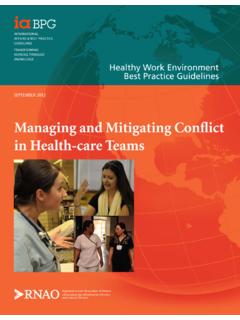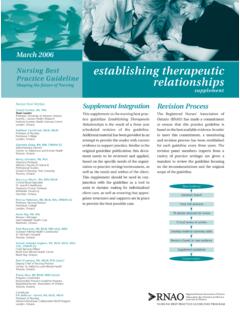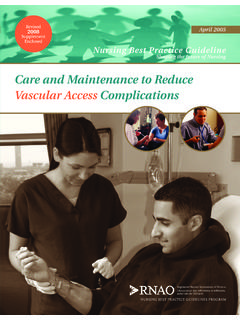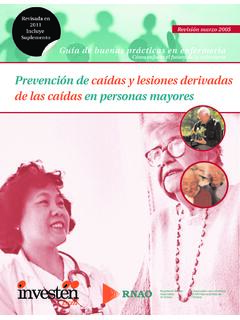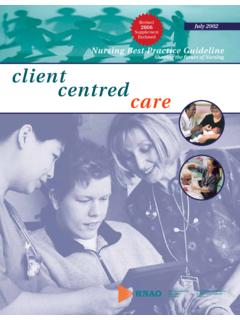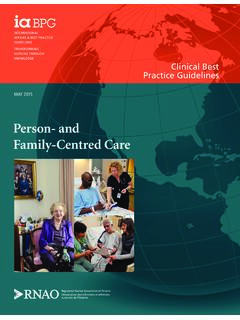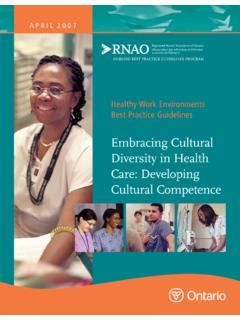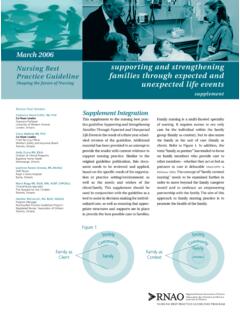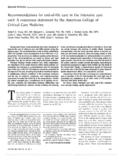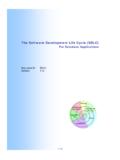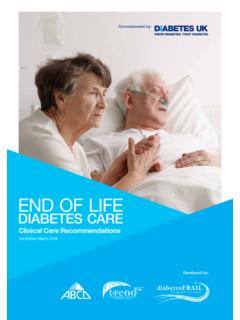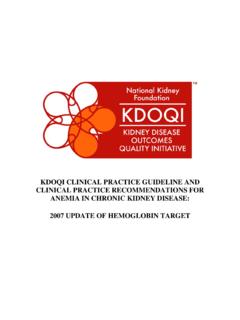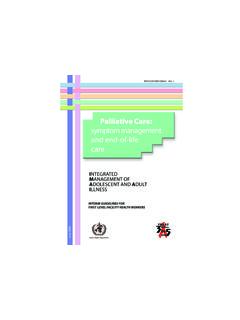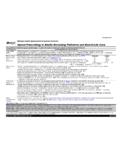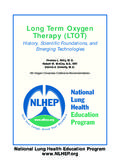Transcription of End-of-life Care During the Last Days and Hours
1 BEST PRACTICE GUIDELINES 1 SEPTEMBER 2011 End-of-life CareDuring the Last days and HoursClinical BestPractice Guidelines2 REGISTERED NURSES ASSOCIATION OF ONTARIOEnd-of- life care During the Last days and HoursDisclaimerThese guidelines are not binding for nurses or the organizations that employ them. The use of these guidelines should be flexible, and based on individual needs and local circumstances. They neither constitute a liability nor discharge from liability. While every effort has been made to ensure the accuracy of the contents at the time of publication, neither the authors nor the Registered Nurses Association of Ontario give any guarantee as to the accuracy of the information contained in them, nor accept any liability, with respect to loss, damage, injury or expense arising from any such errors or omissions in the contents of this work.
2 CopyrightWith the exception of those portions of this document for which a specific prohibition or limitation against copying appears, the balance of this document may be produced, reproduced and published in its entirety, without modification, in any form, including in electronic form, for educational or non-commercial purposes. Should any adaptation of the material be required for any reason, written permission must be obtained from the Registered Nurses Association of Ontario. The appropriate credit or citation must appear on all copied materials as follows: Registered Nurses Association of Ontario.
3 (2011). End-of-life care During the Last days and Hours . Toronto, ON: Registered Nurses Association of Ontario. This program is funded by the Ontario Ministry of Health and Long-Term InformationRegistered Nurses Association of Ontario158 Pearl Street, Toronto, Ontario M5H 1L3 Website: BEST PRACTICE GUIDELINES 1 Greetings from Doris Grinspun,Executive Director Registered Nurses Association of OntarioIt is with great excitement that the Registered Nurses Association of Ontario (RNAO) presents this guideline, End-of-life care During the Last days and Hours , to the health- care community. Evidence-based practice supports excellence in service that nurses are committed to delivering in day-to-day practice.
4 The RNAO is therefore delighted to provide this key resource to you. The RNAO offers its heartfelt thanks to the many individuals and institutions who make our vision for Nursing Best Practice Guidelines (BPGs) a reality: The government of Ontario for recognizing our ability to lead the program, and for providing multi-year funding; Irmajean Bajnok, Director, RNAO International Affairs and Best Practice Guidelines (IABPG) Programs and Centre for Profes-sional Nursing Excellence, for her expertise and leadership in advancing the production of the BPGs; each and every Team Leader involved, and for this BPG in particular Christine McPherson for her superb stewardship, commitment and expertise.
5 Thanks also to Frederick Go, RNAO s IABPG Program Manager, for his intense work to see that this BPG moved from concept to reality. Special thanks are also extended to the BPG Panel we respect and value your expertise and volunteer work. To all, we could not have done this without you!The nursing community, with its commitment to and passion for excellence in nursing care , has provided the knowledge and countless Hours essential to the development, implementation, evaluation and revision of each guideline. Employers have responded enthusiastically by nominating best practice champions, implementing and evaluating the guide-lines and working toward a culture of evidence-based practice.
6 Successful uptake of these guidelines requires a concerted effort from nurse clinicians and their health- care colleagues from other disciplines, and from nurse educators in academic and practice settings and employers. After lodging these guidelines into their minds and hearts, knowledgeable and skillful nurses and nursing students need healthy and supportive work environments to help bring these guidelines into practice actions. We ask that you share this guideline with members of your interprofessional team, as there is much to learn from one another. Together, we can ensure that the public receives the best possible care each and every time they come in contact with us.
7 Let s make them the real winners in this important effort!Doris Grinspun, RN, MSN, PhD, LLD(Hon), DirectorRegistered Nurses Association of OntarioEnd-of- life care During the Last days and HoursEnd-of- life care During the Last days and Hours2 REGISTERED NURSES ASSOCIATION OF ONTARIOHow to use this Document ..4 Summary of Recommendations ..5 Interpretation of Evidence ..9 Development Panel ..10 Stakeholder Acknowledgements ..11 Introduction ..13 Background Context ..13 Guiding Principles ..17 Purpose ..18 Scope ..18 Section 1: Practice Recommendations for Assessment at the End of life .
8 20 Section 2: Practice Recommendations for Decision Support at the End of life ..32 Section 3: Practice Recommendations for care and Management at the End of life ..42 Section 4: Education Recommendations ..49 Section 5: Organization and Policy Recommendations ..55 Research Gaps and Future Implications ..60 Evaluation/Monitoring of Guideline ..62 Implementation Strategies ..65 Process for Update and Review ..66 Table of ContentsBACKGROUNDRECOMMENDATIONSEnd-of- life care During the Last days and Hours BEST PRACTICE GUIDELINES 3 References List ..67 Bibliography ..79 Appendix A: Glossary of Terms ..89 Appendix B: Guideline Development Process.
9 94 Appendix C: Process for Systematic Review/Search Strategy ..95 Appendix D: Tools for Estimating Length of Survival for Individuals at the End of life ..99 Appendix E: Clinical Indicators of Decline ..103 Appendix F: Edmonton Symptom Assessment System (revised version) ..106 Appendix G: Frommelt Attitude Toward care of the Dying Scale ..108 Appendix H: Tips for Conducting a Family Conference ..109 Appendix I: Canadian Hospice Palliative care Association Square of care ..111 Appendix J: Strategies for Helping Individuals Engage in Decision-making at the End of life ..112 Appendix K: Canadian Hospice Palliative care Association Square of care and Organization.
10 114 Appendix L: Tools and Resources ..116 Appendix M: Description of the Toolkit ..118 REFERENCESAPPENDICESEnd-of- life care During the Last days and Hours4 REGISTERED NURSES ASSOCIATION OF ONTARIOHow To Use this DocumentThis nursing best practice guideline is a comprehensive document, which provides resources necessary for the support of evidence-based nursing practice. The document must be reviewed and applied, based on the specific needs of the organization or practice setting/environment, as well as the needs and wishes of the client. This guideline should not be applied in a cookbook fashion, but rather as a tool to enhance decision-making in the provision of individualized care .
